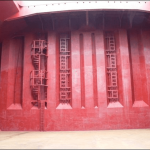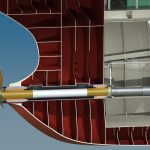In order to prevent the propagation of fire from one compartment to another, all watertight bulkheads are also provided with fire-resistant paneling. However, depending on the extent to which bulkheads can retain the fire and smoke to the affected side, they are classified into three categories:
Class-A Panel: All watertight bulkheads are Class-A type. Bulkheads of Class A must be constructed of steel or equivalent material and should pass the standard fire test, preventing the passage of fire or smoke to the unaffected side for at least one hour. With Class A bulkheads in use, the average temperature on the unaffected side must not exceed 120 degree Celsius. Added to that, there are three categories of Class A panels depending on the time up to which the temperature at any point on the bulkhead must not rise above 160 degree Celsius:
A-60 Panel: 60 minutes.
A-30 Panel: 30 minutes.
A-15 Panel: 15 minutes.
A-0 panel: 0 minutes.
Class-B Panel: Bulkheads of Class B are constructed of materials that are approved by SOLAS and classification societies as incombustible materials. And should pass the standard fire test, preventing the passage of fire or smoke to the unaffected side for at least thirty minutes. With Class B bulkheads in use, the average temperature on the unaffected side must not exceed 120 degree Celsius. There are two types of Class B panels depending on the time up to which the temperature at any point on the bulkhead must not rise above 206 degree Celsius:
B-15 Panel: 15 minutes.
B-0 panel: 0 minutes.
Class-C Panel: Class C bulkheads and decks are constructed of materials that are approved by SOLAS and classification societies as incombustible, but they are not required to meet any requirements related to rise in temperature or passage of smoke and flame to the unaffected side.
Class A and B panels are used adjacent to most of the enclosed spaces within the ship, for example: cargo holds, control stations, stairways, lifeboat embarkation stations, galleys, machinery spaces, tanks, public spaces and accommodation areas. Class C panels are mostly used in open decks and promenades, where requirement of fire safety is minimum. They can also be used between two similar spaces if they are not separated by a watertight bulkhead, in which case a Class A panel is mandatory.



Comments are closed